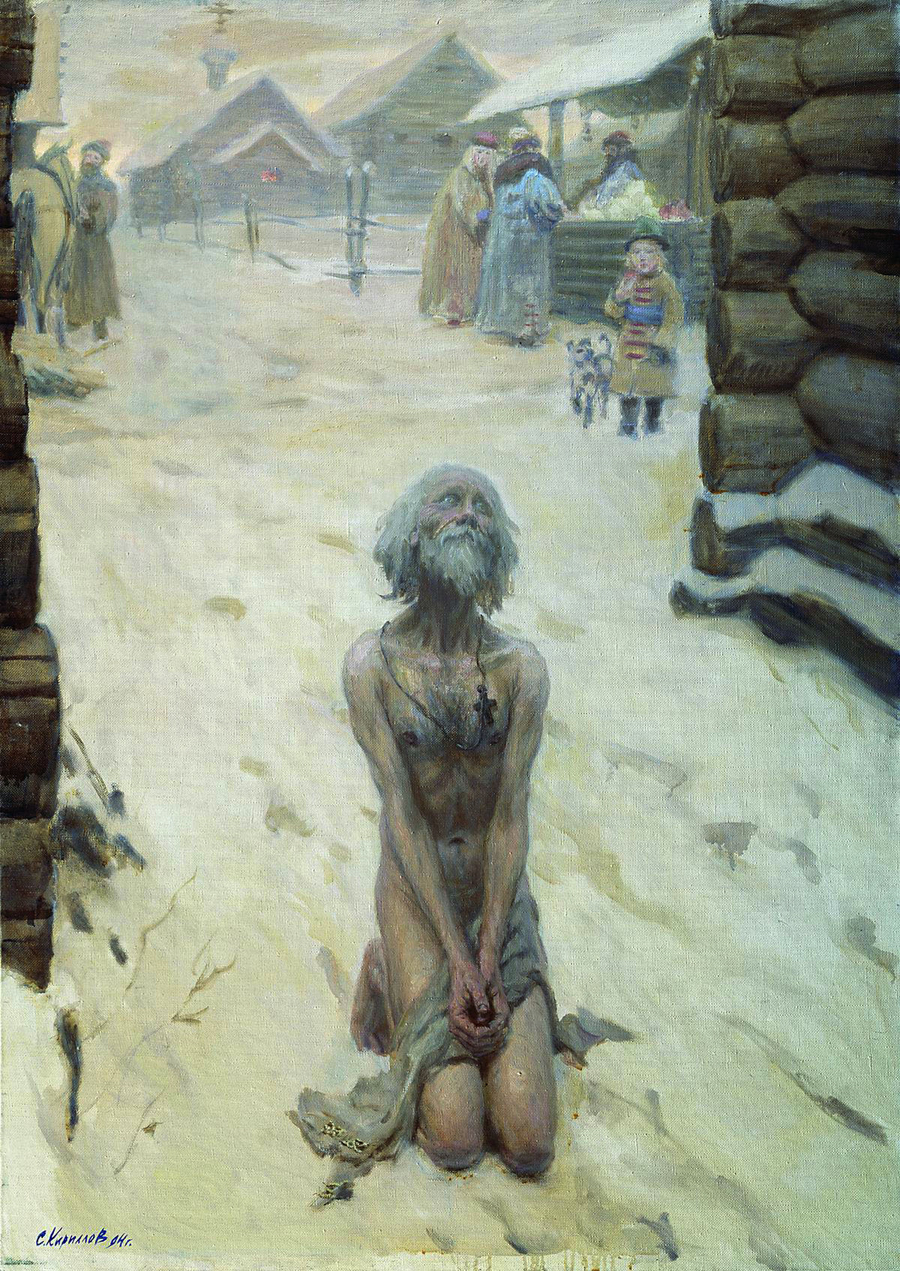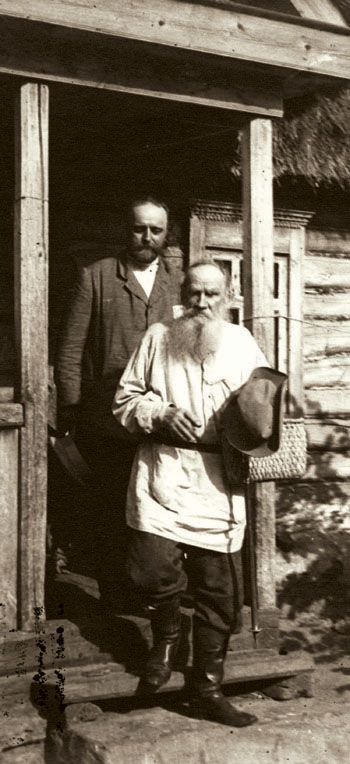|
Alyosha The Pot
"Alyosha the Pot" (russian: Алеша Горшок 'Alyosha Gorshok'' is a short story written by Leo Tolstoy (1905) about the life and death of a simple, uncomplaining worker. It was published after Tolstoy's death in 1911 and received high praise from Tolstoy's contemporaries. D. S. Mirsky considered it "a masterpiece of rare perfection." Without ever calling Alyosha a holy fool, Tolstoy centers the story on his meekness, aloofness, and foolishness. Alyosha's simple life, soft-spoken manner, and calm acceptance of death epitomizes Tolstoyan principles. History The hero and namesake of the story was based on a real person. According to the memoirs of Tatyana Andreevna Kuzminskaya (Lev Tolstoy's sister-in-law), "the assistant to the cook and yard-keeper was the half idiot Alyosha the Pot, who was, for some reason, romanticized to the point that reading about him, I could not recognize our holy fool Alyosha. But, as far as I remember, he was quiet, inoffensive, and meekly did all ... [...More Info...] [...Related Items...] OR: [Wikipedia] [Google] [Baidu] |
Short Story
A short story is a piece of prose fiction that typically can be read in one sitting and focuses on a self-contained incident or series of linked incidents, with the intent of evoking a single effect or mood. The short story is one of the oldest types of literature and has existed in the form of legends, mythic tales, folk tales, fairy tales, tall tales, fables and anecdotes in various ancient communities around the world. The modern short story developed in the early 19th century. Definition The short story is a crafted form in its own right. Short stories make use of plot, resonance, and other dynamic components as in a novel, but typically to a lesser degree. While the short story is largely distinct from the novel or novella/short novel, authors generally draw from a common pool of literary techniques. The short story is sometimes referred to as a genre. Determining what exactly defines a short story has been recurrently problematic. A classic definition of a short story ... [...More Info...] [...Related Items...] OR: [Wikipedia] [Google] [Baidu] |
Leo Tolstoy
Count Lev Nikolayevich TolstoyTolstoy pronounced his first name as , which corresponds to the romanization ''Lyov''. () (; russian: link=no, Лев Николаевич Толстой,In Tolstoy's day, his name was written as in pre-reformed Russian. ; ), usually referred to in English as Leo Tolstoy, was a Russian writer who is regarded as one of the greatest authors of all time. He received nominations for the Nobel Prize in Literature every year from 1902 to 1906 and for the Nobel Peace Prize in 1901, 1902, and 1909; the fact that he never won is a major controversy. Born to an aristocratic Russian family in 1828, Tolstoy's notable works include the novels ''War and Peace'' (1869) and ''Anna Karenina'' (1878), often cited as pinnacles of realist fiction. He first achieved literary acclaim in his twenties with his semi-autobiographical trilogy, ''Childhood'', '' Boyhood'', and ''Youth'' (1852–1856), and '' Sevastopol Sketches'' (1855), based upon his experiences in ... [...More Info...] [...Related Items...] OR: [Wikipedia] [Google] [Baidu] |
Holy Fool
Foolishness for Christ ( el, διά Χριστόν σαλότητα, cu, оуродъ, юродъ) refers to behavior such as giving up all one's worldly possessions upon joining an ascetic order or religious life, or deliberately flouting society's conventions to serve a religious purpose—particularly of Christianity. Such individuals have historically been known as both "holy fools" and "blessed fools". The term "fool" connotes what is perceived as feeblemindedness, and " blessed" or "holy" refers to innocence in the eyes of God.Frith, Uta. (1989) Autism: The Elegant Enigma. Malden, MA: Blackwell Publishing. The term ''fools for Christ'' derives from the writings of Saint Paul. Desert Fathers and other saints acted the part of Holy Fools, as have the ''yurodivy'' (or iurodstvo) of Eastern Orthodox asceticism. Fools for Christ often employ shocking and unconventional behavior to challenge accepted norms, deliver prophecies, or to mask their piety.Parry (1999), p. 233 Old ... [...More Info...] [...Related Items...] OR: [Wikipedia] [Google] [Baidu] |
Tolstoyan
The Tolstoyan movement is a social movement based on the philosophical and religious views of Russian novelist Leo Tolstoy (1828–1910). Tolstoy's views were formed by rigorous study of the ministry of Jesus, particularly the Sermon on the Mount. Tolstoy expressed "great joy" that groups of people "have been springing up, not only in Russia but in various parts of Europe, who are in complete agreement with our views." However, the author also thought it was a mistake to create a specific movement or doctrine after him, urging individuals to listen to their own conscience rather than blindly follow his. In regard to a letter he received from an adherent, he wrote: Beliefs and practices :Tolstoyans, Tolstoyans (Russian language, Russian:''Толстовцы'', ''Tolstovtsy'') identify themselves as Christians, but do not generally belong to an institutional Christian Church, Church. Tolstoy was a harsh critic of the Russian Orthodox Church, leading to his excommunication in ... [...More Info...] [...Related Items...] OR: [Wikipedia] [Google] [Baidu] |
Bibliography Of Leo Tolstoy
This is a list of works by Russian writer Leo Tolstoy (1828–1910), including his novels, novellas, short stories, fables and parables, plays, and nonfiction. Prose Fiction Novels *''War and Peace'' (Война и мир 'Voyna i mir'' 1869) *''Anna Karenina'' (Анна Каренина 'Anna Karenina'' 1877) *''Resurrection'' (Воскресение 'Voskresenie'' 1899) Novellas *''The Autobiographical Trilogy'' (1852-1856) **''Childhood'' (Детство 'Detstvo'' 1852) **'' Boyhood'' (Отрочество 'Otrochestvo'' 1854) **''Youth'' (Юность 'Yunost''' 1856) *'' Sevastopol Sketches'' (''Севастопольские рассказы'' 'Sevastopolskie rasskazy'' 1855–1856) **"Sevastopol in December 1854" (1855) **"Sevastopol in May 1855" (1855) **"Sevastopol in August 1855" (1856) * '' A Morning of a Landed Proprietor'' (''Утро помещика'', 1856) * '' Two Hussars'' (''Два гусара'' 'Dva gusara'' 1856) * '' Family Happiness'' (Сем� ... [...More Info...] [...Related Items...] OR: [Wikipedia] [Google] [Baidu] |
Tolstoyanism
The Tolstoyan movement is a social movement based on the philosophical and religious views of Russian novelist Leo Tolstoy (1828–1910). Tolstoy's views were formed by rigorous study of the ministry of Jesus, particularly the Sermon on the Mount. Tolstoy expressed "great joy" that groups of people "have been springing up, not only in Russia but in various parts of Europe, who are in complete agreement with our views." However, the author also thought it was a mistake to create a specific movement or doctrine after him, urging individuals to listen to their own conscience rather than blindly follow his. In regard to a letter he received from an adherent, he wrote: Beliefs and practices Tolstoyans ( Russian:''Толстовцы'', ''Tolstovtsy'') identify themselves as Christians, but do not generally belong to an institutional Church. Tolstoy was a harsh critic of the Russian Orthodox Church, leading to his excommunication in 1901. Tolstoyans tend to focus more on followin ... [...More Info...] [...Related Items...] OR: [Wikipedia] [Google] [Baidu] |



